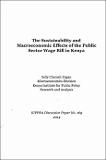| dc.description.abstract | The size of the public sector wage bill has been a central issue of concern to
the government recently. Management of the public wage bill is important for
overall budget sustainability more so because it the wage bill constitutes about
30 per cent of total government expenditure and has increased from Ksh 215
billion in 2008 to Ksh 389.5 billion in 2013, representing an 81.2 per cent change.
In 2013, the wage bill as a per cent of GDP was 10.3 per cent, which is higher
than the ratio for most East African countries and the internationally desirable
level of 7.0 per cent. The objective of this study was to determine whether the public sector wage bill is sustainable. Data used in the study is time series from 1982 to 2012 from the Kenya
National Bureau of Statistics and 2012/13 data from the National Treasury. The
Johansen cointegration test is used to assess the wage bill sustainability, while
scenario analysis using the KIPPRA-Treasury Macroeconomic Model (KTMM)
is used to assess the macroeconomic effects of public sector wage bill. The results of the Johansen co-integration tests (both the trace test and the
maximum eigenvalue test) at 5 per cent level of significance show that the
variables were not co-integrated. The results using KTMM showed that an
increase in government remuneration has effects on volume of consumptions,
imports, GDP at market rate, current account, domestic debt and financial
deficit. The finding from the cointegration suggests that Kenya's public sector wage
bill has no long run relationship and, based on this finding, the study concluded
that Kenya's public sector wage bill is in violation of its inter-temporal budget
constraint and, therefore, unsustainable. Simulations using KTMM showed that
the effects of increased government remuneration by 25 per cent in 2012/13 would
affect macroeconomic indicators responsible for macroeconomic stability. The
fiscal deficit would widen, current account balance would worsen, and increase
public debt. The study recommends that the government reduces the public sector wage bill
by developing a public sector wage policy, optimally utilize the existing human
resources in public service, undertake job evaluation for all cadres of public
sector employees, and fast track legislation on allocation of revenue to various
expenditures. | en |

